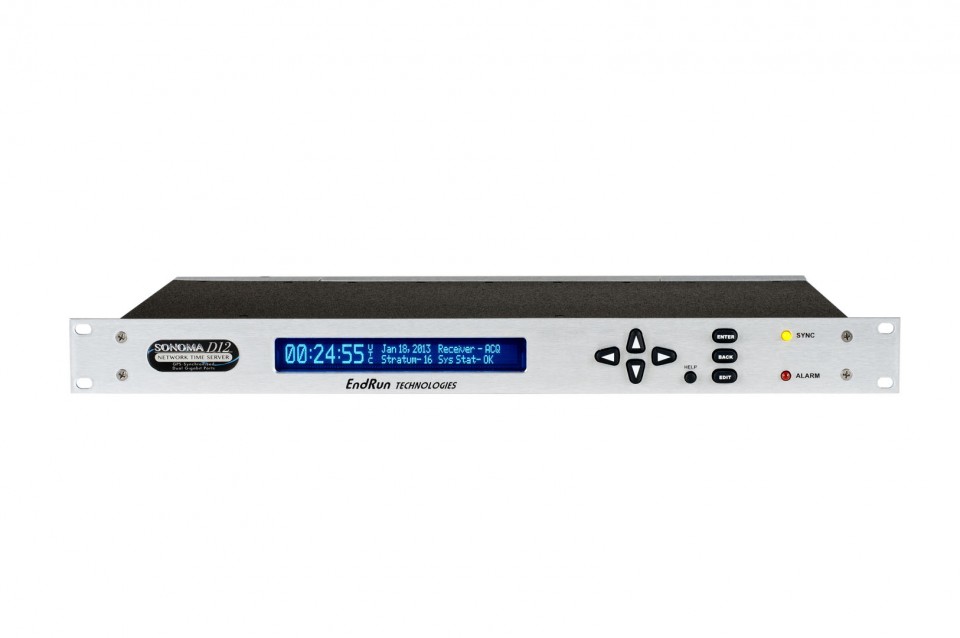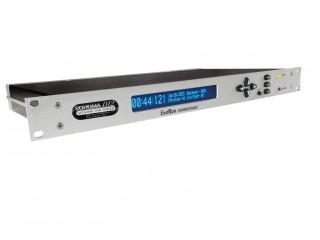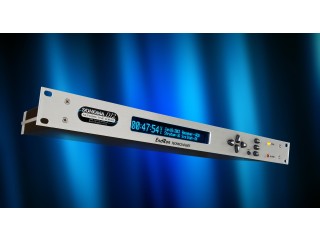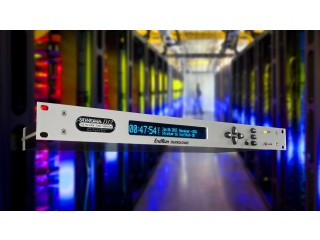EndRun Sonoma D12 Network Time Server (CDMA)
CDMA-Synchronised, Dual Gigabit Ports
[Sonoma-D12-CDMA]Details
Sonoma D12(CDMA)
While installing an antenna on the roof is a typical requirement for most other time servers, with the CDMA-Synchronised Sonoma you can easily mount the antenna inside your building. EndRun Technologies has been designing network time servers since the 1990s, and the Sonoma is the 3rd generation in that standard-setting line. It can serve accurate time to any system running an NTP or SNTP client. With dual gigabit ports and a fast microprocessor for high-capacity throughput (7,500 NTP requests/second), the Sonoma can support hundreds of thousands of NTP clients on your network(s). And with an optional upgrade, it can operate a Precision Time Protocol (PTP) Grandmaster Clock with ahrdwre timestamping on both gigabit ports.
You can easily manage the Sonoma using either of the network ports, the RS-232 serial port or the vibrant display and keypad. A secure Web Interface (HTTPS) is also provided for status monitoring using your Internet browser.
Time Synchronisation to UTC via CDMA Cellular/PCS Signals.
The Sonoma includes a propietary CDMA receiver for synchronisation to Coordinated Universal Time (UTC). It receives its timing information from the Global Positioning System (GPS) via the CDMA mobile telecommunications network used by many cellular/PCS telephones. This means the antenna can be conveniently located inside buildings, anywhere a cell phone signal is available. This saves installation, labor and leasing costs inherent in GPS timing systems and eliminates any risk of damage to your equipment rack due to lightning strikes.
PTP/IEEE-1588 Grandmaster Clock Option
The Sonoma can be configured as a PTP Grandmaster Clock by enabling the PTP/IEEE-1588 option on one or both of the giga bit ports. Using both ports enables one Grandmaster to service two independent PTP sub-domains.
Reliable Hardware Design
The superior reliability of the Sonoma is the result of our very highly-integrated, efficient hardware design that is unique to our products. This design achieves an estimated MTBF of over 25 years (16 years with Rubidium). We do not use general-purpose CPU boards (sometimes referred to as single-board computers (SBC)). Instead, by using the latest semiconductor technologies found in tablet computers, we have achieved an optimal combination of reliability, performance and power consumption.
The CPU is a highly-integrated System-on-Chip (SoC) and the circuitry around it is assembled with 100% soldered-down memory components rather consumer-grade, plug-in, FLASH or DRAM memory modules. The chassis is sealed to keep air currents and dust off sensitive frequency control components. No fans are needed, due to the efficiency of the design. This built-in reliability is combined with a production process which integrates stringent quality assurance inspections and rigorous performance verification.
| Manufacturer | EndRun |
|---|---|
| Part No. | Sonoma-D12-CDMA |
| End of Life? | No |
| Width | 17" |
| Height | 1.75" |
| Depth | 10.75" |
| Weight [Kg] | 2.26 |
| Time to Lock | < 5 minutes, typical (TCXO - standard configuration) < 10 minutes, typical (OCXO/Rb) |
| Synchronisation Accuracy | CDMA Receiver Accuracy - <10 microseconds to UTC (USNO) when locked, typical NTP Timestamp Accuracy - <10 microseconds @ 7,500 requests/second NTP Client Synchronisation Accuracy - Network factors can often limit LAN synchronisation accuracy to 1/2 - 2 milliseconds, typical |
| Holdover Accuracy | TCXO (standard) - 10 millisecs/day. Serves Stratum 1 time for 24 hours after signal loss. Premium OCXO - 80 microsecs/day. Serves Stratum 1 time for 35 days after signal loss. Rubidium - 5 microsecs/day. Serves Stratum 1 time for 140 days after signal loss. |
| Time/Frequency Output | CE, FCC, RoHS, WEEE |
| Timing Protocols | SNTP, NTP v2, v3, v4, SHA/MD5 authentication, broadcast/multicast mode and autokey SSH client/server with “secure copy” utility, SCP SNMP v1, v2c, v3 with Enterprise MIB HTTPS (Web Interface) TIME and DAYTIME server TELNET client/server FTP and DHCP clients SYSLOG IPv4/IPv6 Optional PTP/IEEE-1588-2008 (v2) |
| Network Ports | Two rear-panel RJ-45 jacks Two 10/100/1000 Base-T Ethernet |
| Front Panel | Sync LED: Amber LED pulses to indicate lock status Alarm LED: Red LED indicates a serious fault condition RS-232 serial I/O on rear panel DB9M jack for secure, local terminal access Parameters fixed at 19200 baud, 8 data bits, no parity, 1 stop bit |
| Receivers | CDMA Receiver: Digital Cellular Mobile Receive Band - 869-894 MHz PCS Mobile Receive Band - 1930-1990 MHz Japanese Cellular Mobile Receive Band - 860-875 MHz (optional configuration) TIA/EIA IS-95 CDMA Pilot and Sync Channels TNC Connector (female) on rear panel, Z = 50 Ohms |
| Oscillator | TCXO, OCXO or Rubidium |
| Power | 10 Watts with TCXO (standard configuration). 11-13 watts with OCXO. 16-23 watts with Rb. 90-264 VAC, 47-63 Hz, 1.0A maximum 3-Pin IEC 320 on rear panel, 2-meter cord included |
| Environmental Temperature | Operating: 0˚ to +50˚C Storage: -40° to +85˚C |
| Environmental Humidity | Operating: 5% to 90% RH, non-condensing Storage: 5% to 95% RH, non-condensing |




